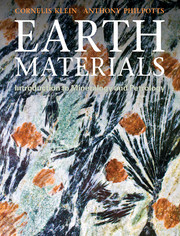Book contents
- Frontmatter
- Contents
- Preface
- Acknowledgments
- Chapter 1 Introduction
- Chapter 2 Materials of the solid Earth
- Chapter 3 How are minerals identified?
- Chapter 4 Fundamentals of crystal structures
- Chapter 5 Introduction to crystallography
- Chapter 6 Minerals and rocks observed under the polarizing optical microscope
- Chapter 7 Igneous rock-forming minerals
- Chapter 8 How do igneous rocks form?
- Chapter 9 Igneous rocks
- Chapter 10 Sedimentary rock-forming minerals and materials
- Chapter 11 Formation, transport, and lithification of sediment
- Chapter 12 Sedimentary rock classification, occurrence, and plate tectonic significance
- Chapter 13 Metamorphic rock-forming minerals
- Chapter 14 Metamorphic rocks
- Chapter 15 Some economic minerals, mainly from veins and pegmatites
- Chapter 16 Some selected Earth materials resources
- Chapter 17 Earth materials and human health
- Glossary
- Minerals and varieties
- Common igneous, sedimentary, and metamorphic rocks
- Index
Chapter 1 - Introduction
- Frontmatter
- Contents
- Preface
- Acknowledgments
- Chapter 1 Introduction
- Chapter 2 Materials of the solid Earth
- Chapter 3 How are minerals identified?
- Chapter 4 Fundamentals of crystal structures
- Chapter 5 Introduction to crystallography
- Chapter 6 Minerals and rocks observed under the polarizing optical microscope
- Chapter 7 Igneous rock-forming minerals
- Chapter 8 How do igneous rocks form?
- Chapter 9 Igneous rocks
- Chapter 10 Sedimentary rock-forming minerals and materials
- Chapter 11 Formation, transport, and lithification of sediment
- Chapter 12 Sedimentary rock classification, occurrence, and plate tectonic significance
- Chapter 13 Metamorphic rock-forming minerals
- Chapter 14 Metamorphic rocks
- Chapter 15 Some economic minerals, mainly from veins and pegmatites
- Chapter 16 Some selected Earth materials resources
- Chapter 17 Earth materials and human health
- Glossary
- Minerals and varieties
- Common igneous, sedimentary, and metamorphic rocks
- Index
Summary
This book provides an introduction to the study of the solids that make up planet Earth. These materials consist of naturally occurring chemical compounds, known as minerals, and their aggregates, rocks. Only through the study of minerals and rocks can we learn about the history of the Earth, and this knowledge is also important because of the extensive use made of Earth materials in everyday life, such as the fabrication of tools; the manufacture of vehicles; and their use as construction materials, sources of energy, and soils for agriculture. This knowledge is clearly important in the search for mineral resources, but the general public needs to know the finite nature of many of our natural resources to make informed decisions.
Many different processes are involved in forming a rock from a group of minerals. These processes are normally divided into three general categories: ones involving molten material, which we call igneous; ones involving the weathering of rock and transport of sediment, which we call sedimentary; and those that modify rocks through changes in temperature, pressure, and fluids inside the Earth, which we call metamorphic . Throughout the book, we first introduce how to identify the minerals that are common in each of these main types of rock, and then we discuss the processes that lead to the formation of those rocks. These processes, many of which are intimately related to plate tectonics, have played important roles in the evolution of the planet.
In the following chapters, we deal with these main types of Earth materials, but in this first chapter we look at where the materials that constitute the Earth came from, and we then review the Earth’s major structural units. The wide compositional range of the many minerals and rocks found on Earth must in some way reflect the composition of the Earth as a whole. It is natural, then, to wonder where the chemical elements that constitute the Earth came from and what determined their abundances.
Information
- Type
- Chapter
- Information
- Earth MaterialsIntroduction to Mineralogy and Petrology, pp. 2 - 13Publisher: Cambridge University PressPrint publication year: 2012
Accessibility standard: Unknown
Why this information is here
This section outlines the accessibility features of this content - including support for screen readers, full keyboard navigation and high-contrast display options. This may not be relevant for you.Accessibility Information
- 1
- Cited by
